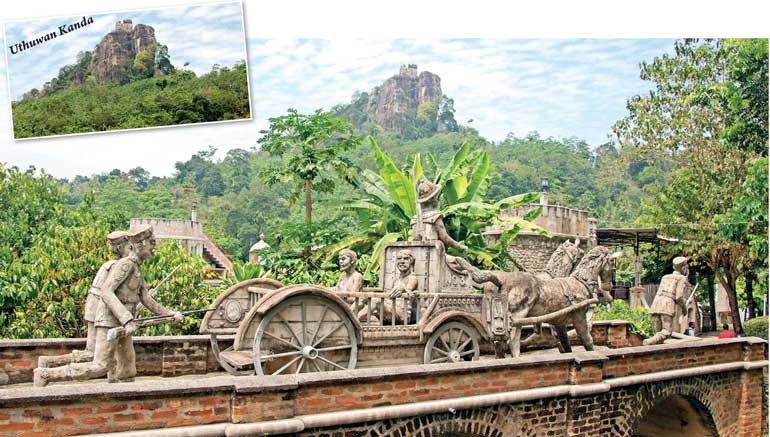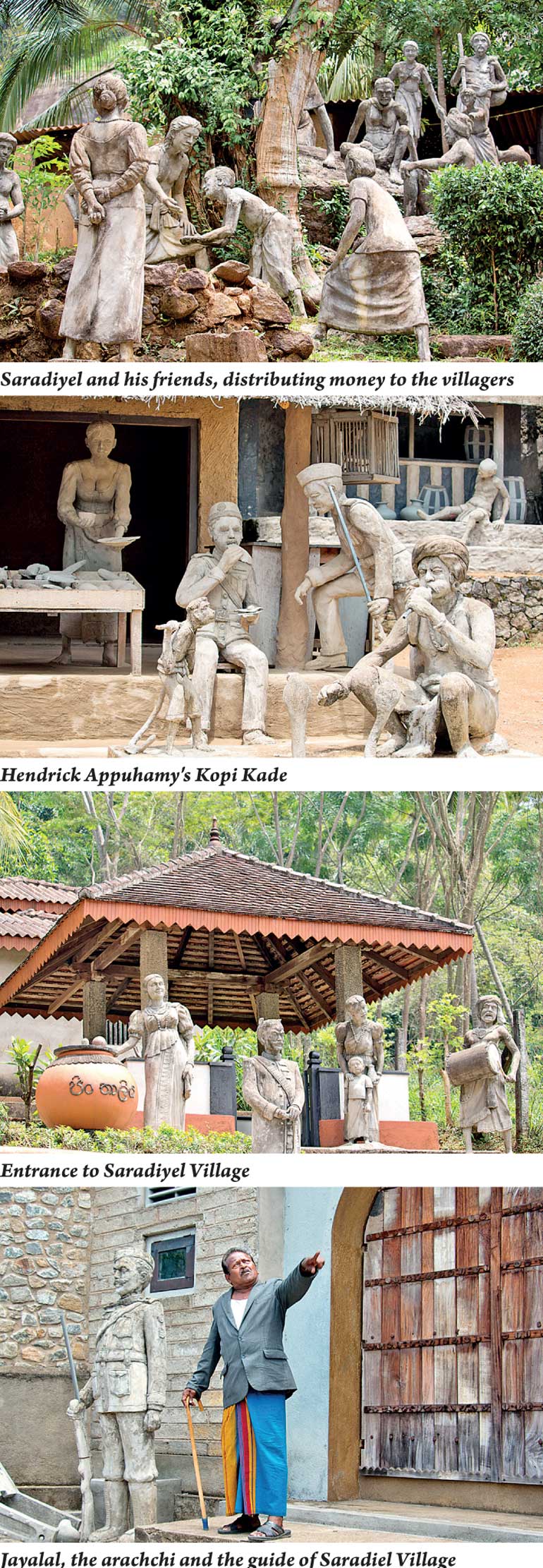Sunday Dec 14, 2025
Sunday Dec 14, 2025
Saturday, 10 March 2018 00:19 - - {{hitsCtrl.values.hits}}

By Aysha Maryam Cassim
Whenever you travel along the Colombo-Kandy road, you’d catch a glimpse of the chimney-like rock known as Uthuwankanda that stands 1,410 feet above sea level. This rock served as Saradiel’s hideout two centuries ago.
Uthuwana is a rural hamlet situated in Mawanella in Kegalle District. It’s the hood of Ceylonese Robin Hood where the Saradiel Village was built. Visiting the village gives you an understanding of Saradiel’s authentic story and the life of 18th century Ceylon.
Who is Saradiel?
Saradiel is famously known as the Robin Hood of Ceylon. Born as Deekirikevage Saradiel Appu, he later became Sura Saradiel owing to his legendary status bestowed upon him by the villagers. He stole from the rich and lent it to the poor, and served as a re-distributor of wealth in the village.
For the British, Young Saradiel was an infamous, notorious rebel. Along with Keppetipola and Veera Puran Appu, Saradiel is often glorified for his gallantry and bravery during anti-colonial struggles. Their objective was to free people from oppression by local elites and whites.
The creator
The creator of Saradiel Village is a doctor by profession. He is also an ardent traveler who saw the benefit of recreating history through visual interaction. The idea of building a village was conceived in his mind during his numerous travel expeditions across the globe. With the collaboration of Kalbhushana Milton Jayapala, Dr. Gamage was finally able to complete the laborious work and unveil it to the public. He started working on his project in 2008 and the final creation was declared open in 2012. The artificially-built village spans across six acres, taking the visitor through different life courses and notable moments in Saradiel’s life. Hundreds and thousands of people visit Saradiel Village and most of them are school children.
Not only will the tour educate you on Saradiel’s life story but the experience will make you comprehend more on the capricious ways that English used their law and order and how the administration blatantly discriminated the locals based on their caste and race.
The tour
As you enter the Saradiel Village, you will be greeted by the Araachchi (headmen) of Beminiwatte. Jayalal portrays the character of arachchi and he does a sterling job at that. Until his arrival, travellers who had come to Saradiel’s Village from every corner of the country can relax in the Ambalama (wayside-inn).
The tour begins from the replica of the vestibule of Aluth Nuwara Temple, after paying respects to Dedimunda Deiyo. It is believed that the God Dedimunda is the guardian deity of the Buddha Sasana.
The Bazaar
The Bazaar in Saradiel’s Village brims with activity. There are sculptures depicting a typical day at Hendrick Appuhamy’s kopi kade. The sculptures perfectly reflect the ethnic harmony and diversity which existed during the Kandyan era.
There is Pichohamy, mother of Saradiel, serving coffee while a Malay police officer enjoys a helapa (a local sweet wrapped in a leaf). In front of the shop is a gypsy snake charmer entertaining the passers-by with his acrobatic monkey. Gypsies are known be descendants of a Thelengu community. Locally, we used to refer to them as Ahiguntikaya (Ahi meaning snake and Guntika, the charmer).
Adjoining the coffee shop, you find the tavern. Back in the old days, village men would drop by here for a pint of toddy. This particular tavern had been run by Renda Raala (Renter) who did not have a good reputation among the villagers.


Experience the feel of an 18th century home
The traditional clay house in the 18th century consisted of different sections known as Diyapila, Watapila and Kottapila. Males in the family would sleep in the Kottapila to guard the house from any outsiders. On the Diyapila, lies a big clay cauldron that was used to quench the thirst of visitors. On the clay wall, there is a built-in shelf to place the trunk pettiya in which valuable belongings were kept. There is a Vee Bissa (Paddy repository) outside the house.
When paddy pods are harvested for the first time, brothers bring them home and the sisters weave a mat to hang it against the wall. Even today, a mat of paddy is hung on the door frame as a symbol of property or sometimes as a part of home decor.
A visit to Arachchi’s house
As the narrator takes you along village scenes, passing the astrologer’s house, carpenter’s atelier, the goldsmith’s workshop and the potter’s, you will be welcomed to Arachchi’s house.
During the Kandyan era, only the village headmen were granted special permission to plaster his walls with lime and thatch the roof with tiles. At the Verandah, there is a Dutch armchair, on which the Arachchi would lounge most of the time while dealing with village issues and settling down disputes.
The Dandu Kadaya outside is a torture device which was used as a method of punishment inflicted on the condemned men.
The tour continues
The second half of the tour takes you back to Saradiel’s childhood and rebellion days. En route, Arachchi would stop by at the ferry, Tikiri Menike’s kitchen and laundry man’s house to explain how the life was lived and trade thrived back in those days.
Saradiel’s last days with Mammale Marikkar
Mammale Marikkar was Saradiel’s most trusted and closest friend. His sister Thangamma was the wife of village haberdasher known as (Mani Petti Karaya) Cader, who used to sell trinkets from house to house.
At the age of 32, Saradiel and Mammale Marikkar were captured by the British and executed on 7 May 1864 in Bogambara. Later their bodies were buried in Mahaiyawa. According to historical records, they were the last two people who were hung in a public venue.
There was so much agitation on the day Saradiel was captured along with Mammale Marikkar. In his book, ‘Saradiel Village,’ Nawaneliye Wijetjunga says that the people who witnessed the hanging of Saradiel had deeply wailed and stated that even the God Seevan could not have seen this serious crime.
Saradiel vehemently fought against English imperialists and got labelled as a bandit by the British. But centuries later, his name and bravery echo over the rocky peaks of Uthuwankanda, reminding us that he was not an outlaw but a hero. If it weren’t for ‘friends’ like Sirimale, who betrayed his friendship and trust for petty benefits, Saradiel could have lived longer and rendered more service for his people.